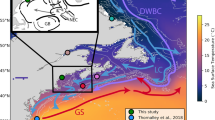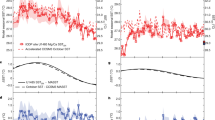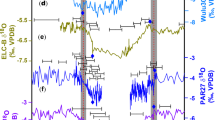Abstract
Arising from: F. Robert & M. Chaussidon Nature 443, 969–972 (2006)10.1038/nature05239; Robert & Chaussidon reply
Abstract
The oxygen isotopes in sedimentary cherts (siliceous sediments) have been used to argue that the Precambrian oceans were hot — with temperatures of up to 70 °C at 3.3 Gyr before present1. Robert and Chaussidon2 measure silicon isotopes in cherts and arrive at a similar conclusion. We suggest here that both isotope trends may be caused by variations in seawater isotope composition, rather than in ocean temperatures. If so, then the climate of the early Earth may have been temperate, as it is today, and therefore more consistent with evidence for Precambrian glaciations and with constraints inferred from biological evolution.
Similar content being viewed by others
Main
By focusing on cherts, Robert and Chaussidon2 have overlooked the much more extensive marine-carbonate oxygen-isotope database3. Marine carbonates can be more easily demonstrated by using strontium isotopes3,4, for example, to relate to the global ocean, whereas two different mineralogies — dolomite [CaMg(CO3)2] and calcite (CaCO3) — are studied in parallel. According to the oxygen- and silicon-isotope data of Robert and Chaussidon2, surface seawater temperatures decreased by 50–60 °C during the Precambrian, mostly between 2.0 Gyr and 1.0 Gyr ago. Such a major change in ocean temperature ought to be recorded in the marine carbonate record by a rise in δ18O values of at least 10‰: however, no such rise is evident.
If only the average values of each unit are plotted (to reduce bias from individual studies with many samples), then a much smaller (∼5‰) rise in carbonate δ18O is seen between 2.5 Gyr and 0.8 Gyr ago3. This rise could represent a much more modest temperature decrease of about 20 °C, which would be more consistent with evidence for glaciation and from fossil and biomarker records of eukaryotes throughout this period in Earth's history.
On the other hand, secular changes in marine chert and carbonate δ18O values, and perhaps δ30Si values as well, need have nothing to do with temperature. The largest shift in carbonate δ18O occurred more recently during the early Palaeozoic4 and has been interpreted as resulting mainly from an increase in seawater δ18O (see refs 4, 5, for example). This is because of the implausibly hot global climate that would need to be inferred were temperature the sole controlling factor on carbonate δ18O during this period of animal expansion.
The secular change in δ18O of cherts can also be explained if seawater isotopic composition changes with time6,7. This possibility, much discussed in the literature, has been overlooked by Robert and Chaussidon2. If the increase in marine chert and carbonate δ18O from the Archaean to the present day were caused by an equivalent increase in seawater δ18O, then it must have been related to a decrease in the relative influence of low- versus high-temperature alteration of the ocean crust5,6,7. Such a decrease could have been caused by changes in tectonic styles associated with decreasing geothermal heat flow7,8. In particular, if the mid-ocean ridge crests were shallower in the past, hydrothermal circulation systems may have penetrated less deeply, and sea water may have interacted with basalts at lower temperatures8.
Such a change in mid-ocean-ridge circulation systems may also explain the trend towards higher seawater δ30Si during the Precambrian noted by Robert and Chaussidon2. In their model, the silicon isotope composition of sea water is controlled by the fraction of silica that leaves the ocean in sediments, f, compared with the fraction, 1 – f, that leaves as a result of hydrothermal silicification of oceanic crust. The latter fraction, 1 – f, depends on the temperature difference between the circulating hydrothermal fluid, Thyd, and sea water, TSW. The smaller the difference between these two numbers, Thyd – TSW, the smaller is the fraction 1 – f and the greater is the fraction f. The authors' data2 show that the early Precambrian was characterized by a greater value of f, or a smaller value of 1 – f, which they interpret as indicating an increase in TSW. The implicit assumption here is that Thyd remains constant. We propose that this change might equally well be caused by a decrease in Thyd, while TSW remains more or less constant. Such a model, driven by changes in heat flow and plate tectonics8, offers a natural explanation for the secular changes in both δ18O and δ30Si in sedimentary rocks — one that does not conflict with the observed record of Precambrian glaciations and biological evolution.
References
Knauth, L. P. & Lowe, D. R. Geol. Soc. Am. Bull. 115, 566–580 (2003).
Robert, F. & Chaussidon, M. Nature 443, 969–972 (2006).
Shields, G. & Veizer, J. Geochem. Geophys. Geosys. 3, 1031 (2002).
Veizer, J. et al. Chem. Geol. 161, 59–88 (1999).
Wallmann, K. Geochim. Cosmochim. Acta 65, 2469–2485 (2001).
Perry, E. C. Earth Planet. Sci. Lett. 3, 62–66 (1967).
Walker, J. C. G. & Lohmann, K. C. Geophys. Res. Lett. 16, 323–326 (1989).
Kasting, J. F. et al. Earth Planet. Sci. Lett. 252, 82–93 (2006).
Author information
Authors and Affiliations
Ethics declarations
Competing interests
The authors declare no competing financial interests.
Rights and permissions
About this article
Cite this article
Shields, G., Kasting, J. Evidence for hot early oceans?. Nature 447, E1 (2007). https://doi.org/10.1038/nature05830
Received:
Accepted:
Published:
Issue Date:
DOI: https://doi.org/10.1038/nature05830
This article is cited by
-
Generation of long-chain fatty acids by hydrogen-driven bicarbonate reduction in ancient alkaline hydrothermal vents
Communications Earth & Environment (2024)
-
Plausible Emergence and Self Assembly of a Primitive Phospholipid from Reduced Phosphorus on the Primordial Earth
Origins of Life and Evolution of Biospheres (2021)
-
An Origin-of-Life Reactor to Simulate Alkaline Hydrothermal Vents
Journal of Molecular Evolution (2014)
-
Climates of the Earth and Cryosphere Evolution
Surveys in Geophysics (2011)
-
Parallel adaptations to high temperatures in the Archaean eon
Nature (2008)
Comments
By submitting a comment you agree to abide by our Terms and Community Guidelines. If you find something abusive or that does not comply with our terms or guidelines please flag it as inappropriate.



